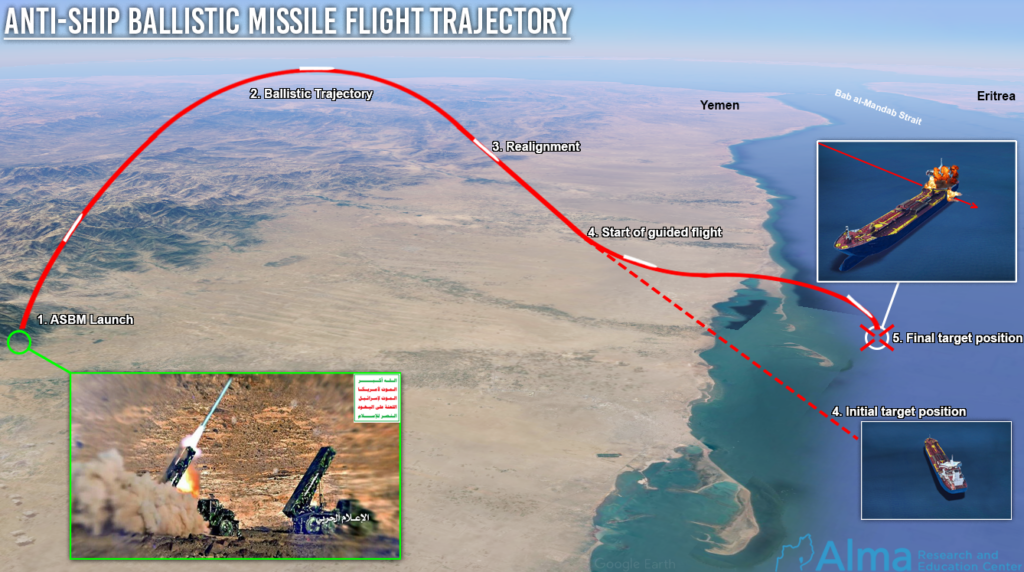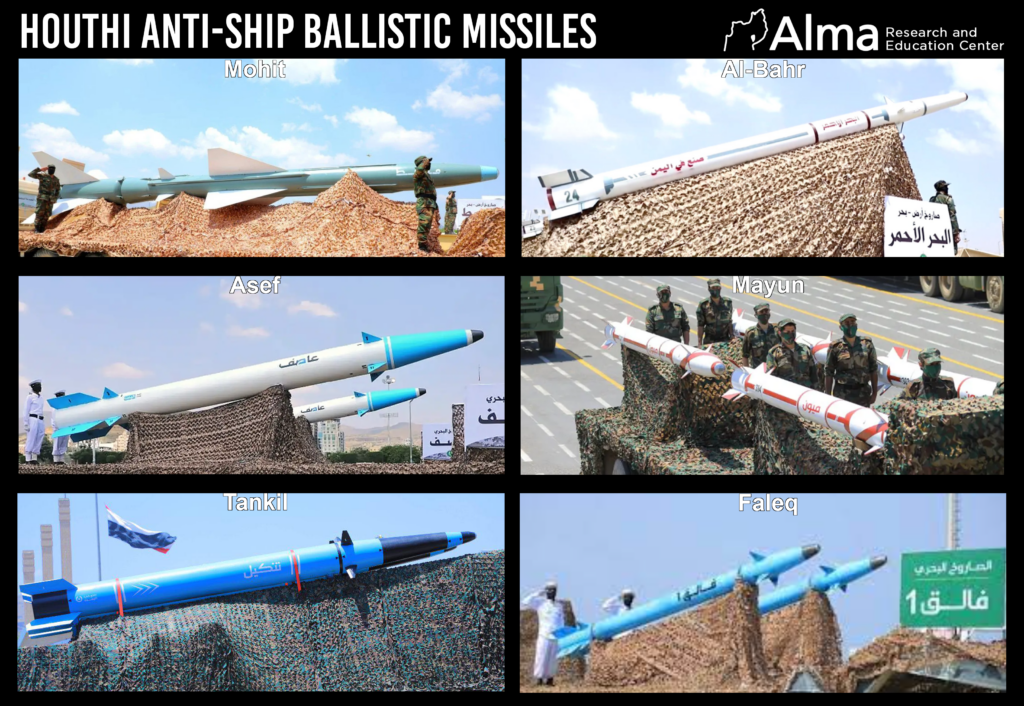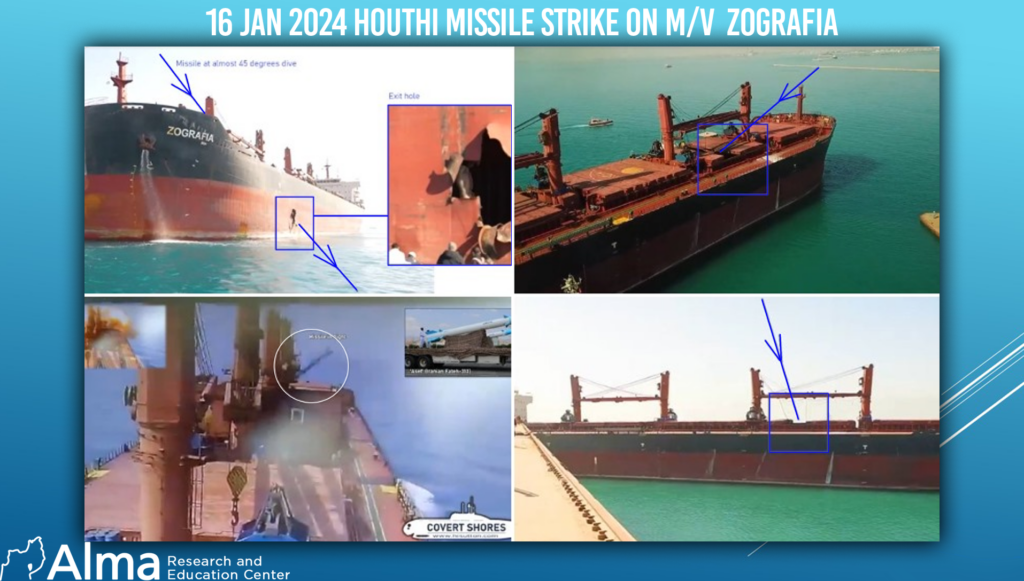By: Yair Ramati and Yaakov Lappin.
The Houthi movement in Yemen, known as Ansar Allah, exploits its strategic location to launch attacks on vessels in the Red Sea and the Indian Ocean while acting under explicit Iranian orchestration.
Between October 2023 and mid-January 2024 (18.1.2024), the Houthis managed to launch a significant number of attacks against maritime targets: 4 cruise missiles (alongside 6 land attack cruise missiles—LACM), dozens of suicide UAVs (95 in total, some against land targets), a single unmanned surface vessel (USV), and no less than 21 ballistic missiles against ships (anti-ship ballistic missiles, or ASBMs). Those unique ASBM arrived at the Houthis directly from Iran.
In the past, almost all of the world’s anti-ship missiles were based on cruise technologies flying horizontally above the water surface (sea-skimming), mostly subsonic.
After some 30 years of Russian pioneering development, China chose to focus on this anti-ship ballistic technology (ASBM).
In recent decades, China has deployed several long-range shore-to-sea ballistic missiles. Their purpose: to create an anti-area access denial access area (A2/AD) and hit US Navy ships in the eastern Pacific Ocean.
Following China, Iran and North Korea stepped forward in this field.
It seems that the Iranians chose to use ballistic missiles against ships based on three main considerations:
A. Diversifying their anti-ship attack array.
B. A better ability to penetrate the “hard” (guns and interceptors) and “soft” defense suits of most ships.
C. A shorter flight time and high arrival speed.
The guidance system method chosen by the Iranians in this context is electro-optic (based on cameras and infrared sensors).
Initially, these capabilities were based on the visible band derived from old American air-ground bombs (Maverick). Later, the Iranians developed a variety of improvements, including infrared sensor capabilities.
The ballistic missile is launched toward the expected maritime target location, where it will meet the target (after a flight time of between 3 and 6 minutes). In this flight phase, the missile guides itself based on classical inertial measurements, for the most part with some satellite guidance (GNSS) system updates.
At a suitable range from the target, the attacking missile ‘opens its eye’ and, from there, it is supposed to home in on it using the optical sensor.


Three missiles stand out in their appearance in parades held by the Houthis for visitors:
• “Mohit” a ballistic missile against ships. A derivative of the Russian 60-year-old air-ground missile, the SA-2.
This has been converted from an old Chinese/Iranian surface-to-surface missile equipped with an electro-optic guidance sensor and advanced avionics systems. The missile has a range of up to 180 km and carries a warhead weighing about 150 kg.
• “Asef” a maritime variation apparently of the “Fateh-313″ surface-to-surface missile, with a maximum range of about 450 km and a special warhead developed by Iran, weighing about 300 kg (some argue 380 or even 550 kg). It is a non-separating, single missile, about 8.8 meters long, and has a diameter of 0.61 meters.
• “Tankil” a maritime variation of “Raad-500” with a range of 500 km and also from the same Iranian surface-to-surface missile family (similar external appearance, slightly larger) and apparently featuring the same warhead. Some believe that it also has a penetrating separating body. The Iranians called this maritime version Zohayr. The Houthis announced its existence relatively recently, only in 2022.

In addition, attention should be paid to:
“Falaq,” which is about 6 meters long and relatively short-range, between about 140 and 200 km. The Houthis declare that this missile is a product of their own development (quite doubtful). Some believe it is a maritime version of the Iranian-guided missile Fajr-4CL.
Two additional short-range missiles exist: “Mayun” and “Bahr al-Ahmar,” and there is almost no reliability in the public domain about them.
The Houthis have good access to the Red Sea and only partial access to the Indian Ocean. This does not prevent them from launching armaments towards targets in the Indian Ocean, but it complicates the use of coastal bases in this area.
Since 2015, the Houthis have been attacking maritime targets in the area. Initially, anti-tank guided missiles (ATGMs) were launched from ships or the coast before later becoming armed with shore-to-sea missiles and establishing no less than 30 radar observation stations, which are now being attacked by US and UK-led coalition forces.
The main challenges in operating ballistic missiles with electro-optical guidance against ships are as follows:
- Intelligence, Command, and Control: The long-range missiles require establishing a coherent maritime situation picture at long ranges beyond the horizon.
- Knowledge of weather far from the country’s shores (it is doubtful if such capability exists in the hands of the Houthis).
The Houthis managed to achieve several hits on maritime targets in the area, mainly civilian. On the other hand, despite launching a significant number of anti-ship ballistic missiles, the number of hits recorded so far remains limited.
Some commentators have indirectly referred to these results, and a summary of their assessments suggests the following:
- The technology of shore-to-sea ballistic missiles with electro-optical guidance is complex, and apparently, the Iranian products require a further maturation period. Obviously, it is assumed that the lessons are being learned these days in the Iranian research institutes.
- The maritime target acquisition technique based on electro-optical homing seekers is still immature.
- American electronic warfare (EW) disrupts the GNSS signals by denial of spoofing, thereby diverting them from the required endgame ‘basket’.
Regarding defense means, only some of the American ships are equipped with AEGIS weapon systems and proper SM-6 interceptors to counter such threats.
Apparently, European warships do not have significant capabilities against this threat.
What are Hezbollah’s capabilities in the area of anti-ship ballistic missiles against Israel?
Hezbollah does not need to operate along the ranges at which the Houthis fire at their targets. But it is possible that Hezbollah has such short-range models of ASBMs. The Mediterranean Sea is a different, more crowded theater, but with some shore stations of radar and observation posts and other data sources, the Hezbollah might engage Israeli and international targets in the Mediterranean.
It should be mentioned that the Israeli Navy has various defense systems to cope with this same threat, unlike the European warships.






One Response
Do the Houthi have their own command and control or is it largely provided by the Iranian ship that lingers offshore?